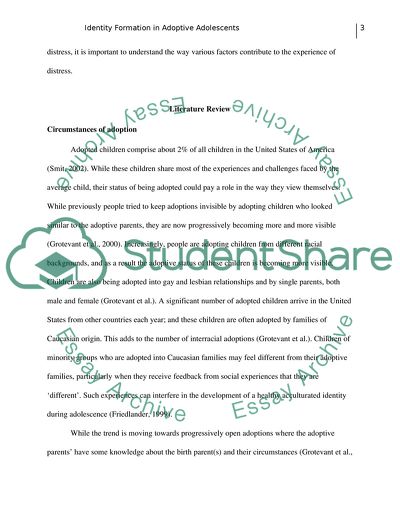Cite this document
(Identity Formation in Adopted Adolescents: Challenges and Concerns Research Paper Example | Topics and Well Written Essays - 2500 words, n.d.)
Identity Formation in Adopted Adolescents: Challenges and Concerns Research Paper Example | Topics and Well Written Essays - 2500 words. https://studentshare.org/psychology/1771426-pick-a-topic-in-human-growth-and-development-and-within-the-realms-of-psychology-and-do-a-research-paper-info-and-lots-of-detail-provided
Identity Formation in Adopted Adolescents: Challenges and Concerns Research Paper Example | Topics and Well Written Essays - 2500 words. https://studentshare.org/psychology/1771426-pick-a-topic-in-human-growth-and-development-and-within-the-realms-of-psychology-and-do-a-research-paper-info-and-lots-of-detail-provided
(Identity Formation in Adopted Adolescents: Challenges and Concerns Research Paper Example | Topics and Well Written Essays - 2500 Words)
Identity Formation in Adopted Adolescents: Challenges and Concerns Research Paper Example | Topics and Well Written Essays - 2500 Words. https://studentshare.org/psychology/1771426-pick-a-topic-in-human-growth-and-development-and-within-the-realms-of-psychology-and-do-a-research-paper-info-and-lots-of-detail-provided.
Identity Formation in Adopted Adolescents: Challenges and Concerns Research Paper Example | Topics and Well Written Essays - 2500 Words. https://studentshare.org/psychology/1771426-pick-a-topic-in-human-growth-and-development-and-within-the-realms-of-psychology-and-do-a-research-paper-info-and-lots-of-detail-provided.
“Identity Formation in Adopted Adolescents: Challenges and Concerns Research Paper Example | Topics and Well Written Essays - 2500 Words”. https://studentshare.org/psychology/1771426-pick-a-topic-in-human-growth-and-development-and-within-the-realms-of-psychology-and-do-a-research-paper-info-and-lots-of-detail-provided.


